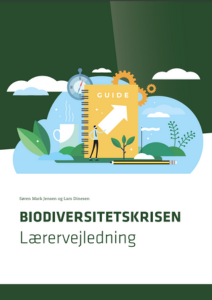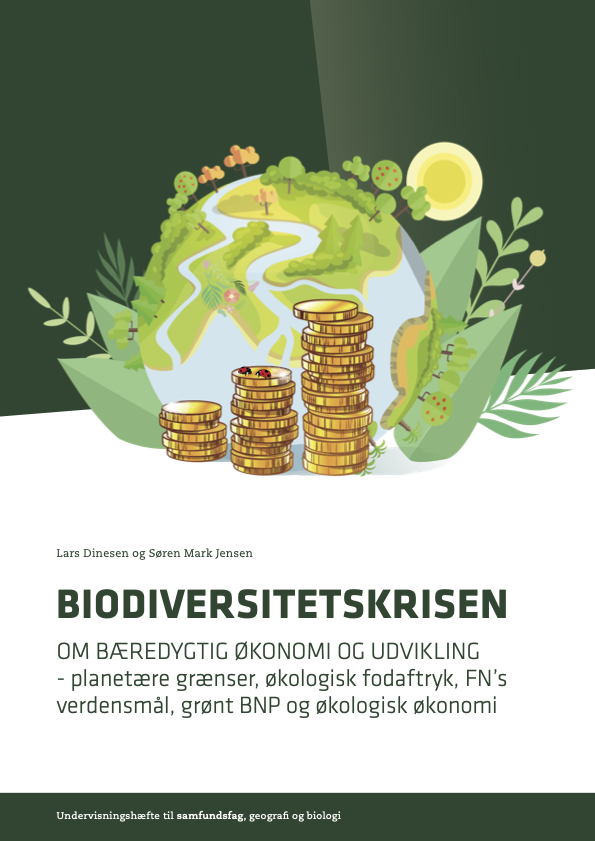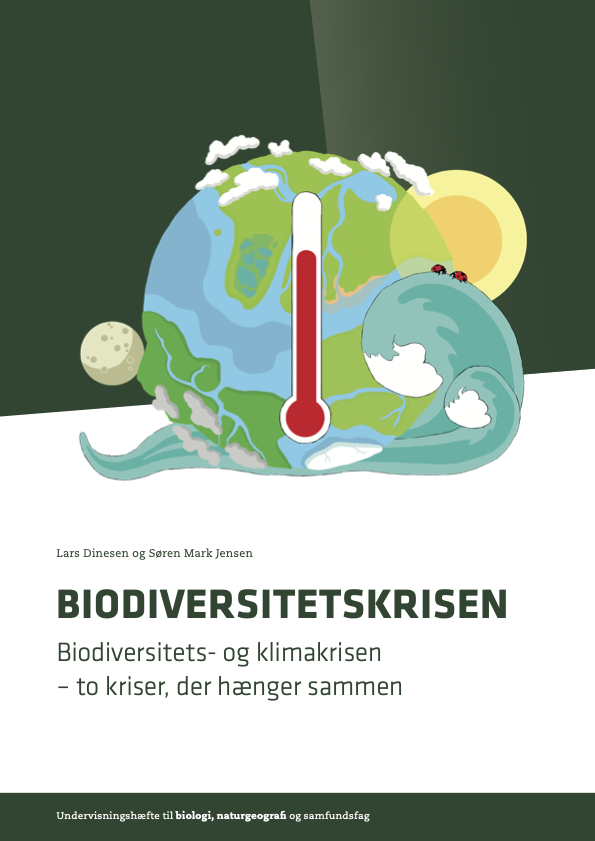Teacher’s guide for the three booklets

The teacher’s guide aims to inspire teachers to use the booklets, which can be employed for classroom teaching, role play, group work, theme weeks or individual assignments and projects.
The booklets contain a series of student exercises, new academic figures, and fact boxes, etc., which can also be used by the teacher in connection with the preparation of exam topics and questions.
The appendix at the end of the guide provides an explanation on how the use of the booklets aligns with the academic objectives and core material for upper secondary subjects such as biology, social studies, and geography at the C level. Additionally, the booklets can also be used at the B and A levels.
Booklet 1: THE BIODIVERSITY CRISIS. HOW SERIOUS IS IT? WHAT IS CAUSING THE CRISIS? HOW DO WE STOP IT?

The booklet starts with a brief introduction to biodiversity and its importance, followed by a short overview of core functions and processes in nature, such as photosynthesis and the carbon cycle. It then explores how biodiversity has emerged and is distributed across the Earth, along with how severe and extensive the biodiversity crisis is, both globally and in Denmark. The main topics covered throughout the booklet include species diversity and the geographic regions where the highest number of species are found, and why this is the case. Additionally, it highlights the rate at which certain species groups are going extinct, how many species are threatened within various groups, and why. It also provides examples of species that have recovered. A key topic in this booklet is the question of why we are facing a biodiversity crisis and what the main threats of it are. The booklet also provides examples of biodiversity monitoring, which include new data collection techniques such as the use of drones and environmental DNA. Finally, it concludes with a discussion of actions that can be taken to reverse the trend. The booklet contains eight student exercises.
Quality assurance of the booklet’s content has been carried out by Associate Professor Anders Barfod, Aarhus University, Associate Professor Sara Egemose, University of Southern Denmark, Senior Researcher Martin Lindegren, DTU Aqua and Professor Katherine Richardson, University of Copenhagen.
Booklet 2:
THE BIODIVERSITY CRISIS
– ON SUSTAINABLE ECONOMY AND DEVELOPMENT – PLANETARY BOUNDARIES, ECOLOGICAL FOOTPRINT, UN SUSTAINABLE DEVELOPMENT GOALS, GREEN GDP, AND ECOLOGICAL ECONOMICS

The booklet is based on the development of ecosystem services and the impact and interactions of different societal and production sectors (e.g., agriculture, forestry, and fisheries) on nature. It includes a review of 18 services, including pollination, food, clean drinking water, nutrient removal, and the use of wood, as well as the development of indicators for these services. The majority are in decline, while a few that directly provide immediate benefits for humans are increasing. The booklet focuses on planetary boundaries, ecological footprint, and the “doughnut model” in relation to providing a status and finding solutions for sustainable development. The UN Sustainable Development Goals are examined, and there is an explanation of the agreed-upon nature-related goals within the UN. The booklet concludes with a discussion of how to incorporate biodiversity into economic accounting methods and models such as green national accounting, green GDP, and green economics. Solutions are also discussed, and the booklet includes eight student exercises.
Quality assurance of the booklet’s content has been carried out by Professor Katherine Richardson, University of Copenhagen, Professor Niels Strange, University of Copenhagen, and Professor Henrik Vejre, University of Copenhagen.
Booklet 3: THE BIODIVERSITY CRISIS – THE BIODIVERSITY AND CLIMATE CRISIS – TWO CRISES THAT ARE CONNECTED

This booklet provides a brief overview of the development of the biodiversity and climate crises, with a focus on how the two global crises are interconnected. It therefore examines the carbon cycle and how climate change affects biodiversity. The booklet highlights the consequences of global warming for both animal and plant species, as well as ecosystems, both globally and in Denmark. It also explains why the two crises are very different, emphasizing how the climate crisis is much simpler to understand and set global goals for, in comparison with the biodiversity crisis. Since the two crises are intertwined, some of the solutions are also shared, and there are approaches that can help reverse the trend for both crises. There are specific Danish examples of how biodiversity restoration—nature-based solutions—can help address the climate crisis and the negative impact that the destruction of carbon-rich ecosystems can have on climate regulation. The booklet also focuses on forests, wetlands, and ocean resources. Solutions are discussed both at the societal level and in terms of what individuals like you and I can do. The booklet contains six student exercises.
Quality assurance of the booklet’s content has been carried out by Professor Katherine Richardson, University of Copenhagen, Professor Sebastian Mernild, University of Southern Denmark, Professor Torsten Nygaard Kristensen, Aalborg University, and Associate Professor Sara Egemose, University of Southern Denmark.
The booklets are printed in a limited edition. Inquiries regarding printed copies can be directed to the Danish IPBES office.